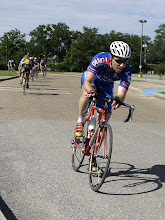Serotta Symposium Day 2
If one day of PhD level research presentations wasn't enough, here we go again for day two.
Dan Heil, PhD did a review of literature that related to optimal cycling position. Dan reviewed some of his own research as well as other works. Here's the pearl for the weekend. Dan did a study of shoulder position and it's effect on HR, VO2 max and Ventilation. His research confirmed for me that riders search for a shoulder position that requires the least amount of isometric contraction to provide stabilization. This is why riders move forward to the nose of their saddles. Riders don't move forward to gain a pedaling advantage. Basically the results showed heart rate increases of 20-40 bpm simply due to overloading the shoulder musculature. Who can afford that?
Rick Neptune reviewed his research on computer models that predict work load and joint load with cycling effort. I'm hoping to participate in a project with him in the future. I'm interested in forces that cause frontal plan moments. These forces cause the rider to adjust his/her riding path to keep the bike upright. Rick has four kids. He rides a tripple. He's the pilot, his wife it the stoker, the oldest daughter is in the third position. Next oldest is in a child seat on the back. The younder two ride in a trailer behind the bike. Now that's living.
Christopher Kautz gave the most reasonable presentation on triathlon position that I've ever heard. For once, here's a guy who's not screaming "FORWARD, FORWARD, LOWER, LOWER, STEAPER, STEAPER, STEAPER!". His premise was very simple. As a cyclist, we have to be able to maintain balance, stability, power, biomechanical efficiency, comfort and digestion/breathing. For the triathlete, we add aerodynamics. Notice, we add to the existing requirements. We don't throw them out the window. He reported that most triathletes probably belong in a fairly conservative position so that they can get the most out of the bike. I was very impressed. I'm committed to help triathletes become better cyclists.
Andy Pruitt discussed the medical aspects of bicycle fit. He reviewed specific overuse injuries associated with poor fit or poor technique. I liked one of his initial statements. "It's our job to help the bike look like the rider(paraphrase)". It doesn't do any good to make the rider look like the bike. Just because the bike looks fast with the handlebars 6" below the saddle, it doesn't mean that Joe rider is going to be able to tolerate it.
I'm still trying to digest all of the information. It was a huge honor to be able to attend this sympsium. I really came away with a more detailed understanding of bicycle fit and the physics of cycling performance.


0 Comments:
Post a Comment
<< Home